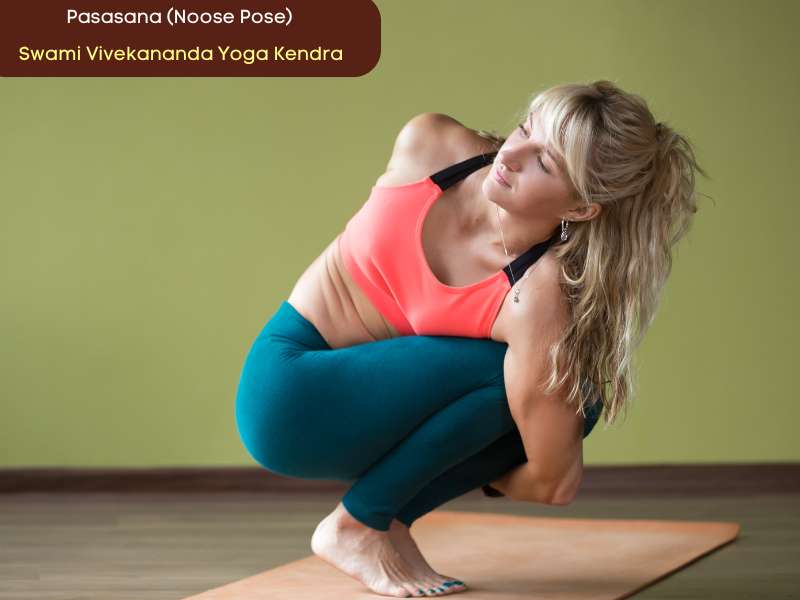At Swami Vivekananda Yoga Kendra, we’re always excited to share yoga poses that not only challenge the body but also help you feel more grounded, refreshed, and alive. One such pose is Pasasana, also known as the Noose Pose. Don’t let the name intimidate you! Pasasana is a deep squatting twist that can do wonders for your spine, digestion, and mental clarity. It may look tricky at first, but with a little patience and practice, it becomes a powerful part of your wellness routine.
Step-by-Step: How to Do Pasasana (Noose Pose)
You don’t need to be a yoga pro to try this — just come with an open mind and a steady breath. Let’s break it down simply:
1. Start in a Comfortable Squat
Begin by squatting down, like you would in Malasana (yogi squat). Try to keep your feet together and heels on the ground. If your heels lift up, place a rolled towel or blanket under them for support.
2. Begin the Twist
Now, twist your upper body to the right side. Bring your left upper arm across your right thigh so it presses against the outer thigh. Think of turning from your belly and chest, not just your neck.
3. Add the Arm Bind (Optional)
Reach your right hand behind your back, and your left hand underneath your thighs, trying to clasp your fingers or wrists behind you. If your hands don’t touch (totally normal!), use a yoga strap or towel to bridge the gap.
4. Breathe and Hold
Once you’re in position, stay in the pose for 3 to 5 slow, deep breaths. Keep your face soft, chest open, and shoulders away from your ears. When you’re done, gently release and repeat on the other side.
5. Return to Standing
Come out of the squat slowly and stand in Tadasana (Mountain Pose). Pause for a moment and notice how you feel. You might feel a bit taller, lighter, and more open.
Why Practice Pasasana (Noose Pose)? (Benefits You’ll Feel)
Pasasana may not be the most “Instagram-famous” pose, but the benefits go deep:
1. What if I can’t twist that far or bind my hands?
That’s completely okay! Just focus on the twist itself. Using a strap or just reaching your arms in the right direction still gives you all the benefits.
2. Why is it hard to balance in this pose?
Because it challenges your squat, twist, and balance all at once! Try placing a blanket under your heels or practicing near a wall for extra support.
3. Can Pasasana help with constipation or bloating?
Yes, absolutely! The abdominal compression in this pose stimulates digestion and can help relieve bloating and sluggish digestion.
4. Should I avoid this pose if I have knee or ankle pain?
Yes — if squatting causes pain, try a gentler twist while seated in a chair or on the floor. Always listen to your body.
5. When is the best time to practice Pasasana?
Morning is ideal, especially before breakfast. But anytime your body feels tight or your digestion needs a boost, it’s a great pose to explore.
Ready to Twist with Us?
Join us at Swami Vivekananda Yoga Kendra, where our experienced teachers guide you step by step through grounding poses like this — with no pressure to be perfect.
Wrapping It Up: Small Pose, Big Results
Pasasana may not be the easiest pose at first, but it teaches you a lot — not just about balance and flexibility, but about patience, persistence, and the joy of trying something new.
At Swami Vivekananda Yoga Kendra, we see every pose as a doorway to self-discovery. So take it one breath at a time, be kind to your body, and remember: the journey is just as important as the pose itself.
Transform Your Life with us: Join Our Online Classes Now:
Ready to dive into a world of wellness? Come join us for some online meditation classes to find your inner calm, hop into our online yoga classes to take your practice up a notch, or why not even become a certified yoga teacher? Embrace the power of yoga today and let it lead you to a happier, healthier you!


Comments are closed.